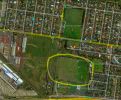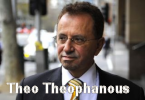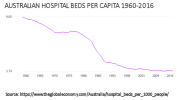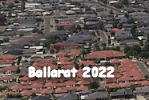Text and video of Rob Thurley speech at the Stop the Great Wall of Frankston Rally 13 May 2023
Note. The text has not yet been transcribed.
Note. The text has not yet been transcribed.

 The Australian people, and most journalists, are being gaslighted by the Treasury budget papers’ superficial analysis of Australia’s immigration and population growth. That this is being let go to the keeper by virtually all media commentary is extraordinary, according to Sustainable Population Australia (SPA).
The Australian people, and most journalists, are being gaslighted by the Treasury budget papers’ superficial analysis of Australia’s immigration and population growth. That this is being let go to the keeper by virtually all media commentary is extraordinary, according to Sustainable Population Australia (SPA).
 Dr Dorina Pojani is Associate in urban planning at the University of Queensland, Australia, with a degree in Urban Planning from Albania.
Dr Dorina Pojani is Associate in urban planning at the University of Queensland, Australia, with a degree in Urban Planning from Albania.
 There is a new policy blog or political movement called Low Migration Australia. It is very well written and explains the relevant concepts succinctly. The movement was started by Edward Smith. Well worth a look.
There is a new policy blog or political movement called Low Migration Australia. It is very well written and explains the relevant concepts succinctly. The movement was started by Edward Smith. Well worth a look.
We have republished from the page entitled, "In a nutshell," from "Low Migration Australia" at https://lowmigrationaustralia.org/
A new report finds that Australia’s housing crisis cannot be solved without a major slowing of population growth.
 Where To From Here - Victorian Local Government Elections 2024; Save Our Canopy Trees – April 1 Forum; Planning and Heritage Inquiry; Level Crossing Removal FOI; VCAT Protest?; Let There Be Light – Brunswick Residents Have a Win; Planning Scheme Amendment St Phillip St Brunswick East; Guest Speaker at Fitzroy Residents Association; John Curtin Hotel; Royal Exhibition Building and Carlton Gardens; Western Port Woodlands Alliance Formed; MAB Attempts to Silence Westmeadows Re
Where To From Here - Victorian Local Government Elections 2024; Save Our Canopy Trees – April 1 Forum; Planning and Heritage Inquiry; Level Crossing Removal FOI; VCAT Protest?; Let There Be Light – Brunswick Residents Have a Win; Planning Scheme Amendment St Phillip St Brunswick East; Guest Speaker at Fitzroy Residents Association; John Curtin Hotel; Royal Exhibition Building and Carlton Gardens; Western Port Woodlands Alliance Formed; MAB Attempts to Silence Westmeadows Re
 The CFMEU has placed a green ban on a proposed site of an indoor sports stadium at McIver Reserve in Yarraville that will reduce the provision and access to open space for the local community. McIver Reserve is a key community hub for recreation and leisure. The proposed reduction of open space in a council with already limited provision of open space shows a lack of regard to the views of local residents by Council.
The CFMEU has placed a green ban on a proposed site of an indoor sports stadium at McIver Reserve in Yarraville that will reduce the provision and access to open space for the local community. McIver Reserve is a key community hub for recreation and leisure. The proposed reduction of open space in a council with already limited provision of open space shows a lack of regard to the views of local residents by Council.
 Contents: Page 1 – Heritage Amendment Bill 2023; Victorian Departmental Restructure; Australian Architecture President Bells the Cat; Legislative Council Planning and Heritage Inquiry; Page 2 – Submissions Closing on World Heritage Management Plan for Royal Exhibition Building and Carlton Gardens; Speech to CROWAG, and April Forum; Level Crossing Removal FOI; War on Plastic – Clean Up Australia Day; Page 3 – South Australia’s Planning Minister Flags Change
Contents: Page 1 – Heritage Amendment Bill 2023; Victorian Departmental Restructure; Australian Architecture President Bells the Cat; Legislative Council Planning and Heritage Inquiry; Page 2 – Submissions Closing on World Heritage Management Plan for Royal Exhibition Building and Carlton Gardens; Speech to CROWAG, and April Forum; Level Crossing Removal FOI; War on Plastic – Clean Up Australia Day; Page 3 – South Australia’s Planning Minister Flags Change
 Presentation by The Hon. Kelvin Thomson, Convenor of Planning Democracy, to Combined Residents of Whitehorse Action Groups, (CROWAG) Wednesday 15 February, Blackburn Lake Visitor Centre.
Presentation by The Hon. Kelvin Thomson, Convenor of Planning Democracy, to Combined Residents of Whitehorse Action Groups, (CROWAG) Wednesday 15 February, Blackburn Lake Visitor Centre.
 In this issue: Victorian Parliament Resumes; Protecting Democracy and Amenity – 15 February Blackburn Speech; Facebook Page; Save Lake Knox; Ryman Healthcare; Mount Eliza Development; CROWAG April Public Forum – Save Our Canopy Trees; Stop the Great Wall of Frankston; Long Reserve Langwarrin; Concrete coming out of the Moonee Ponds Creek; War on Plastic; Kilmore Land Upda
In this issue: Victorian Parliament Resumes; Protecting Democracy and Amenity – 15 February Blackburn Speech; Facebook Page; Save Lake Knox; Ryman Healthcare; Mount Eliza Development; CROWAG April Public Forum – Save Our Canopy Trees; Stop the Great Wall of Frankston; Long Reserve Langwarrin; Concrete coming out of the Moonee Ponds Creek; War on Plastic; Kilmore Land Upda
 In this issue: 1.WELCOME TO 2023; 2.VCAT DELAYS; 3.STOP THE GREAT WALL OF FRANKSTON; 4.SUNBURY HIGH RISE TO GO TO VCAT; 5.KILMORE BUSHFIRE EVACUATION ISSUE; 6.BAD NEWS ON THE MORNINGTON PENINSULA; 7. KINGSWOOD GOLF COURSE; 8.477 SYDNEY RD. COBURG – BIKE SPACES, BUT NO CARS PLEASE; 9. PLANNING DEMOCRACY FACEBOOK PAGE; 10. WORLD HERITAGE MANAGEMENT PLAN OVERVIEW; 11.
In this issue: 1.WELCOME TO 2023; 2.VCAT DELAYS; 3.STOP THE GREAT WALL OF FRANKSTON; 4.SUNBURY HIGH RISE TO GO TO VCAT; 5.KILMORE BUSHFIRE EVACUATION ISSUE; 6.BAD NEWS ON THE MORNINGTON PENINSULA; 7. KINGSWOOD GOLF COURSE; 8.477 SYDNEY RD. COBURG – BIKE SPACES, BUT NO CARS PLEASE; 9. PLANNING DEMOCRACY FACEBOOK PAGE; 10. WORLD HERITAGE MANAGEMENT PLAN OVERVIEW; 11.
 Recently the South Australian premier called for higher immigration in his water-scarce state. This was followed by a similar plea from the Northern Territory government, which is seeking more workers, and is spending $12.8m on a campaign to attract them for the hospitality industry.
Recently the South Australian premier called for higher immigration in his water-scarce state. This was followed by a similar plea from the Northern Territory government, which is seeking more workers, and is spending $12.8m on a campaign to attract them for the hospitality industry.
 A new report confirms beyond doubt that rapid population growth is the main cause of Australia’s housing affordability crisis, notes Sustainable Population Australia (SPA). While interest rates and government policies influence short-term trends in house prices, it is population growth that has driven house price inflation long-term.
A new report confirms beyond doubt that rapid population growth is the main cause of Australia’s housing affordability crisis, notes Sustainable Population Australia (SPA). While interest rates and government policies influence short-term trends in house prices, it is population growth that has driven house price inflation long-term.
 Independent Broad-based Anti-corruption Commission (IBAC) Today the Independent Broad-based Anti-corruption Commission (IBAC) tabled a special report in Parliament highlighting improper conduct by former Victorian Government Minister Theo Theophanous in his role on the board of the Victorian Planning Authority (VPA).[1] [Candobetter comment: Note that the VPA is is a major decision maker in planning in Victoria and in promoting population
Independent Broad-based Anti-corruption Commission (IBAC) Today the Independent Broad-based Anti-corruption Commission (IBAC) tabled a special report in Parliament highlighting improper conduct by former Victorian Government Minister Theo Theophanous in his role on the board of the Victorian Planning Authority (VPA).[1] [Candobetter comment: Note that the VPA is is a major decision maker in planning in Victoria and in promoting population
 In 1960 Australia had 9.65 hospital beds per 1000 people. This number shrank to 3.84 hospital beds in 2016, with a low in 2013 of 3.74. A very slight increase to 3.9 beds per 1000 people in 2017-2018. Between 1960 and 2021 Australia's population grew from 10.28 million to 25.69 million people. This is a growth of 150.0 percent in 61 years.
In 1960 Australia had 9.65 hospital beds per 1000 people. This number shrank to 3.84 hospital beds in 2016, with a low in 2013 of 3.74. A very slight increase to 3.9 beds per 1000 people in 2017-2018. Between 1960 and 2021 Australia's population grew from 10.28 million to 25.69 million people. This is a growth of 150.0 percent in 61 years.
More and more farming land is being lost to other land uses such as housing on the outskirts of our cities. But how much land is being lost? And why does it matter?
 The following message about shocking proposals for a wall of multistorey appartments on the fragile banks of Frankston's much-loved Kananook Creek, was sent on 12 January 2023 to members and friends of The Port Phillip Conservation Council.
The following message about shocking proposals for a wall of multistorey appartments on the fragile banks of Frankston's much-loved Kananook Creek, was sent on 12 January 2023 to members and friends of The Port Phillip Conservation Council.
"Canada introduces ban on foreigners buying property, allows exceptions for refugees and permanent residents - ABC News" https://www.abc.net.au/news/2023-01-02/canada-bans-foreigners-from-buying-property/101821128.
Response to new Centre for Population report: Australia must stabilise its population below 30 million to stop the growing impacts on climate and biodiversity, as well as preserve quality of life, according to the environment organisation Sustainable Population Australia (SPA). SPA president, Ms Jenny Goldie, was commenting on the latest report from the ‘Centre for Population’, the Treasury office which advises the federal government on population. Their report is due to be released Friday 6 January.
 In this issue: VICTORIAN ELECTION FOLLOW-UP; HUME COUNCIL APPROVES FIVE STOREY DEVELOPMENT IN SUNBURY; RYMAN HEALTH 6 STOREY APPLICATION NOW BEFORE MOONEE VALLEY COUNCIL; CROWAG 2023 TREE COVER FORUM; CROYDON CONSERVATION SOCIETY UPDATE; GOOD NEWS 1.
In this issue: VICTORIAN ELECTION FOLLOW-UP; HUME COUNCIL APPROVES FIVE STOREY DEVELOPMENT IN SUNBURY; RYMAN HEALTH 6 STOREY APPLICATION NOW BEFORE MOONEE VALLEY COUNCIL; CROWAG 2023 TREE COVER FORUM; CROYDON CONSERVATION SOCIETY UPDATE; GOOD NEWS 1.
 Newly elected president of World Council of Non-Human Species addresses Humanity about the biodiversity crisis. Geoffrey the Giraffe also calls attention to plummeting number of giraffes. (Slava Abramovitch Unsplash)
Newly elected president of World Council of Non-Human Species addresses Humanity about the biodiversity crisis. Geoffrey the Giraffe also calls attention to plummeting number of giraffes. (Slava Abramovitch Unsplash)
 "To date, I understand that 2,268 jurisdictions in 39 countries have declared a climate emergency. It is the one issue about which there is widespread global consensus. It presents a common threat to all countries and no country can isolate itself from it. However, to effectively tackle climate change, there must be an equal focus on population growth and the disastrous effect it is having on the earth's natural environment. To date, there is little evidence of governments doing that.
"To date, I understand that 2,268 jurisdictions in 39 countries have declared a climate emergency. It is the one issue about which there is widespread global consensus. It presents a common threat to all countries and no country can isolate itself from it. However, to effectively tackle climate change, there must be an equal focus on population growth and the disastrous effect it is having on the earth's natural environment. To date, there is little evidence of governments doing that.
 You’re the culprit. Unfolding collapse is down to you. Forget population overshoot. You’re consuming too much. Own it!
You’re the culprit. Unfolding collapse is down to you. Forget population overshoot. You’re consuming too much. Own it!
 Entitled, "Growing Regional Victoria," the Victorian Chamber of Commerce and Industry is pushing yet more growth in infrastructure and housing on regional Victoria, with the accompanying short-term jobs and destruction of environment, space, and biodiversity. Anyone travelling through regional Victoria (and almost any Australian state) will notice the drab housing estates with their ever meaner lots and devegetated surrounds, wedging miscellaneous drifts of precarious humans desperate for accommodation
Entitled, "Growing Regional Victoria," the Victorian Chamber of Commerce and Industry is pushing yet more growth in infrastructure and housing on regional Victoria, with the accompanying short-term jobs and destruction of environment, space, and biodiversity. Anyone travelling through regional Victoria (and almost any Australian state) will notice the drab housing estates with their ever meaner lots and devegetated surrounds, wedging miscellaneous drifts of precarious humans desperate for accommodation
 Any new inquiry into Australia’s migration program needs to assess the full costs and benefits of population growth, especially the costs to our environment and the risks of collapse. I wish I had a dollar for every pro-population-increase article I have read that begins by telling the reader that Australia is a nation of immigrants, with some 25% born overseas and about 50% with at least one parent born overseas.
Any new inquiry into Australia’s migration program needs to assess the full costs and benefits of population growth, especially the costs to our environment and the risks of collapse. I wish I had a dollar for every pro-population-increase article I have read that begins by telling the reader that Australia is a nation of immigrants, with some 25% born overseas and about 50% with at least one parent born overseas.
 Liberal or Labor
Liberal or Labor
It's urban sprawl
Labor or Liberal
Its build up tall
Whoever you vote for
in this state election,
Liberal or Labor
There' ll be no correction
It's grow til we die
It's build them up high
It's fill up the country
And to hell with the sky
Build them tall and urban sprawl: the growth-lobby's blueprint for Melbourne or any other city in Australia
Recent comments